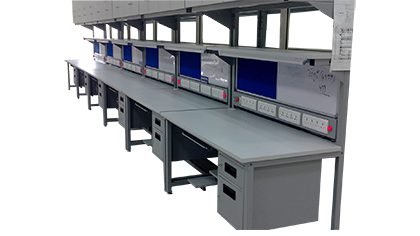How to Set Up an ESD Safe Workstation: The Ultimate Guide to Electrostatic Discharge Protection
- vidith cc
- May 4
- 4 min read
In the electronics industry, whether you're assembling PCBs, repairing devices, or designing embedded systems, electrostatic discharge (ESD) is an invisible enemy that can silently damage sensitive electronic components. Even a small zap of static electricity — often too weak to feel — can destroy or degrade components like microprocessors, memory chips, and integrated circuits.
That’s why setting up a proper ESD safe workstation is not just a best practice — it’s a necessity.
This comprehensive guide covers everything you need to know about setting up an ESD-safe workstation, including essential tools, setup procedures, ESD safety standards, and maintenance tips. Whether you’re an electronics hobbyist, engineer, or manufacturer, this post will help you build a compliant and effective anti-static workstation that meets professional standards.

What Is ESD and Why Is It Dangerous?
Electrostatic discharge (ESD) is the sudden flow of electricity between two electrically charged objects. It can happen when you walk across a carpet and touch a metal doorknob — or when you handle a microchip without proper precautions.
Here’s why ESD is a serious concern:
Invisible damage: Most ESD events go unnoticed but can still degrade component performance.
Component failure: Damage may be immediate or latent, leading to intermittent problems or total failure.
Cost implications: Failed components increase RMA rates, reduce reliability, and damage your brand.
Benefits of an ESD Safe Workstation:
An ESD protected area (EPA) ensures that your workspace remains static-free, minimizing risk during the handling and assembly of static-sensitive devices. Key benefits include:
Reduced hardware failures
Increased customer satisfaction
Compliance with industry standards like ANSI/ESD S20.20 and IEC 61340
Longer product life cycles
Lower production and repair costs
Step-by-Step: How to Set Up an ESD Safe Workstation
1. Choose the Right Workbench and ESD Mat
Start with a static-dissipative work surface, ideally an ESD mat placed on a grounded workbench.
What to look for:
Resistance range of 10⁶ to 10⁹ ohms
Multi-layer construction (typically a dissipative top and conductive bottom layer)
Grounding snap to connect to the common point ground
2. Ground Everything with a Common Point Ground
All conductive and dissipative surfaces — including your mat, wrist strap, and any grounded tools — must connect to a single common ground point (CGP) to ensure equal potential.
You’ll need:
Grounding cords
Ground blocks or banana jacks
Electrical verification tester
Pro Tip: Never daisy-chain your ground connections — use a central hub.

3. Wear an ESD Wrist Strap — Always
The most effective way to eliminate static buildup on your body is to wear an ESD wrist strap connected to ground.
Choose an adjustable wrist strap with good skin contact
Verify conductivity regularly
Use with a coiled grounding cord for flexibility

4. Control the Environment
Humidity, flooring, clothing, and temperature all affect static buildup. Your workspace must be designed to minimize charge generation.
Environmental controls to consider:
Maintain humidity levels between 40–60% using humidifiers
Use ESD-safe flooring (anti-static vinyl, rubber, or epoxy)
Wear ESD-safe lab coats and avoid synthetic clothing

5. Use Only ESD-Safe Tools and Accessories
Ordinary tools and storage solutions can generate static. Instead, equip your workstation with ESD-safe tools, which are made with dissipative or conductive materials.
Must-have items:
ESD tweezers and screwdrivers
Static-safe soldering equipment
Anti-static bins, trays, and component storage boxes
Shielding bags for ICs and PCBs
6. Add an Ionizer for Extra Protection
When you work with non-conductive materials (like plastic packaging or PCB substrates), static charges can’t dissipate through grounding alone. This is where ionizers come in.
What ionizers do:
Emit positive and negative ions
Neutralize surface charges on insulators
Provide a static-free workspace even with non-grounded objects

7. Test and Maintain Your Setup
An ESD-safe workstation is only as good as its maintenance. Regularly test:
Wrist strap continuity
Mat resistance
Ground integrity
Use tools like:
ESD wrist strap tester
Surface resistance meters
Ground monitors
ESD Safety Standards You Should Know:
If you’re serious about static protection, consider aligning your workstation with industry standards:
ANSI/ESD S20.20: Widely used in North America
IEC 61340-5-1: Global standard for EPA setup
MIL-STD-1686: Common in aerospace and defense sectors
Frequently Asked Questions (FAQ)
Can I use a regular mat or table for ESD-sensitive work?
No. Regular surfaces can build and hold static charge. Use a certified ESD mat with proper grounding.
Is ESD protection necessary for all electronics?
Not always, but any component marked as Electrostatic Sensitive Device (ESD) — like CMOS chips or SSDs — should only be handled in a protected area.
What if I don’t feel the static?
You usually won’t. ESD damage often occurs without any sensation or visible spark — that’s what makes it so dangerous.
Final Thoughts
Setting up an ESD-safe workstation is the foundation of responsible electronics work. Whether you’re repairing smartphones, designing IoT devices, or running an SMT production line, protecting your components from electrostatic discharge is essential.
With the right setup, tools, and maintenance plan, you can build a reliable ESD protected area that enhances quality, reduces returns, and extends the life of your devices.
Need Help Getting Started?
Let us help you source the best ESD-safe tools, mats, wrist straps, and ionizers for your specific needs. Drop a comment below, or contact us directly for personalized advice.

%20(65).png)








